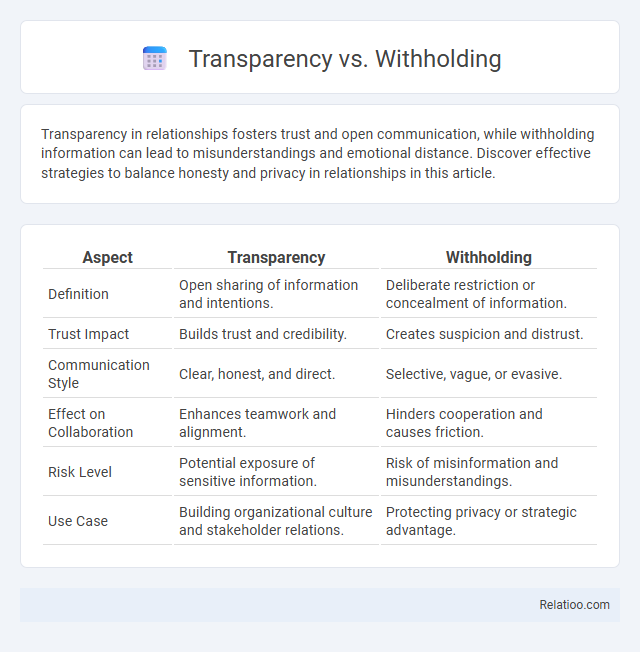Transparency in relationships fosters trust and open communication, while withholding information can lead to misunderstandings and emotional distance. Discover effective strategies to balance honesty and privacy in relationships in this article.
Table of Comparison
| Aspect | Transparency | Withholding |
|---|---|---|
| Definition | Open sharing of information and intentions. | Deliberate restriction or concealment of information. |
| Trust Impact | Builds trust and credibility. | Creates suspicion and distrust. |
| Communication Style | Clear, honest, and direct. | Selective, vague, or evasive. |
| Effect on Collaboration | Enhances teamwork and alignment. | Hinders cooperation and causes friction. |
| Risk Level | Potential exposure of sensitive information. | Risk of misinformation and misunderstandings. |
| Use Case | Building organizational culture and stakeholder relations. | Protecting privacy or strategic advantage. |
Defining Transparency and Withholding
Transparency involves openly sharing information, thoughts, and feelings with clarity and honesty to build trust and foster effective communication. Withholding refers to deliberately choosing to keep certain information private or undisclosed, often to protect oneself or others, which may sometimes result in ambiguity or misunderstandings. Your ability to balance transparency and withholding shapes your relationships by influencing the level of trust and openness between you and others.
The Importance of Open Communication
Open communication fosters trust and clarity, essential for effective relationships and teamwork. Transparency involves sharing relevant information openly, while withholding can create misunderstandings and erode confidence. Honest expression balances truthfulness with empathy, ensuring messages are conveyed sincerely without unnecessary harm.
Risks Associated with Withholding Information
Withholding information in communication can lead to misunderstandings, eroded trust, and damaged relationships due to perceived dishonesty or manipulation. Transparency promotes accountability and fosters stronger collaboration by ensuring all parties have access to accurate and complete data. Honest expression balances the need for openness with sensitivity, reducing the risks associated with withholding critical information while maintaining respect and clarity.
Benefits of Transparent Practices
Transparent practices foster trust and accountability in your relationships, promoting open communication that reduces misunderstandings. By sharing information honestly, you create an environment where collaboration thrives and problems are addressed swiftly. This openness enhances reputation and motivates others to engage sincerely, leading to stronger, more authentic connections.
Ethical Considerations in Information Sharing
Ethical considerations in information sharing require balancing transparency, withholding, and honest expression to protect privacy while maintaining trust. Transparent communication fosters accountability and informed decision-making but must be weighed against the potential harm of revealing sensitive information. You must evaluate the ethical impact of information disclosure to ensure integrity without compromising confidentiality.
Impact on Trust and Credibility
Transparency fosters trust by openly sharing information and intentions, which enhances credibility through consistent honesty. Withholding information can erode trust, as perceived secrecy often leads to suspicion and doubt about motives or reliability. Honest expression, even when conveying difficult truths, strengthens long-term credibility by demonstrating integrity and respect for the audience's right to accurate information.
Transparency vs Withholding in Workplace Settings
Transparency in workplace settings fosters trust, improves collaboration, and enhances decision-making by openly sharing relevant information with Your team. Withholding critical details, however, can lead to misunderstandings, decreased morale, and a toxic work environment. Prioritizing transparency ensures clarity, accountability, and a culture where employees feel valued and empowered.
Strategies for Balancing Transparency and Confidentiality
Effective strategies for balancing transparency and confidentiality include establishing clear guidelines on information sharing that align with organizational values and legal obligations. Implementing tiered access controls and communication protocols ensures sensitive data is protected while promoting honest expression within teams. Encouraging open dialogue within defined boundaries fosters trust and accountability, maintaining transparency without compromising confidentiality.
Real-World Examples: Transparency and Withholding Outcomes
Transparency in leadership fosters trust, as seen in companies like Patagonia that openly share their environmental impact, resulting in strong customer loyalty. Withholding information, however, often leads to mistrust and reputational damage, exemplified by the Volkswagen emissions scandal that eroded consumer confidence. Your choice to prioritize honest expression can either build or break relationships, depending on how transparently you communicate critical information.
Best Practices for Fostering Transparency
Fostering transparency involves openly sharing relevant information while respectfully withholding sensitive details to maintain trust and professionalism. Best practices include clear communication channels, consistent feedback loops, and creating a safe environment where honest expression is encouraged without fear of judgment. Your commitment to balancing transparency and discretion enhances collaboration and strengthens relationships within any organization or team.

Infographic: Transparency vs Withholding
 relatioo.com
relatioo.com